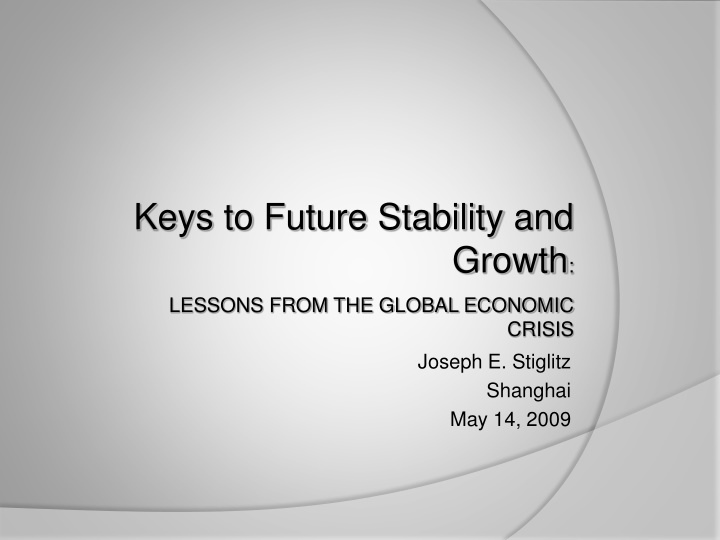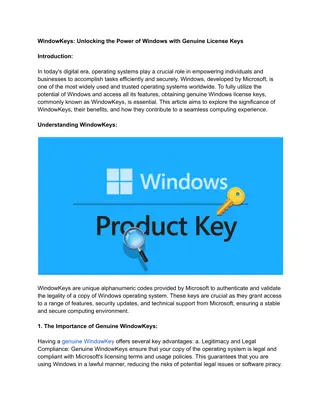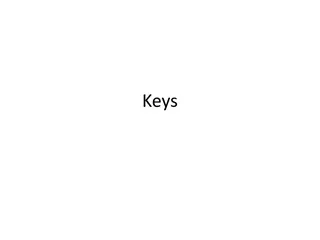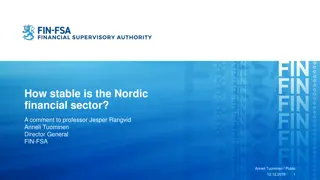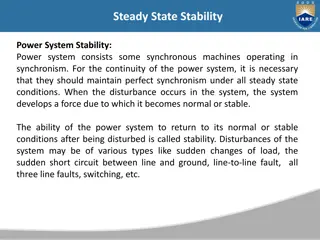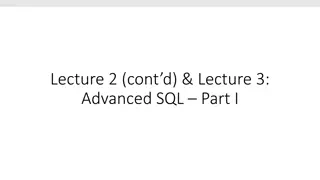Keys to Future Stability and Growth
Failures of America's financial system, innovations, and where the system failed in the current crisis. Key factors in designing a new regulatory structure for a 21st-century financial system.
Download Presentation

Please find below an Image/Link to download the presentation.
The content on the website is provided AS IS for your information and personal use only. It may not be sold, licensed, or shared on other websites without obtaining consent from the author.If you encounter any issues during the download, it is possible that the publisher has removed the file from their server.
You are allowed to download the files provided on this website for personal or commercial use, subject to the condition that they are used lawfully. All files are the property of their respective owners.
The content on the website is provided AS IS for your information and personal use only. It may not be sold, licensed, or shared on other websites without obtaining consent from the author.
E N D
Presentation Transcript
Keys to Future Stability and Growth: LESSONS FROM THE GLOBAL ECONOMIC CRISIS Joseph E. Stiglitz Shanghai May 14, 2009
Failures of Americas Financial System Didn t manage risk created risk Misallocated capital Too much into housing, too little to real investment, innovative sector, improving environment High transaction costs Resisted creation of an efficient electronic transfer system Predatory lending practices
Failures of Americas Financial System Innovations directed at regulatory, accounting, and tax arbitrage Little innovation at meeting society s real needs For example, managing the risk of most family s most important asset their home Failed at both micro and macro level Major social problems devastation of the poor in America Global macro-problem
Model didnt work Self-regulation didn t work Perverse incentives Self-regulation can t work externalities Model of risk diversification (securitization) didn t work Increased information asymmetries Systems of market checks and balances failed (credit rating agencies) Regulatory checks and balances failed Ideology Ideology Capture Capture
The current crisis and where the system failed Incentives Market participants had incentives to engage in excessive risk taking/short sighted behavior Conflicts of interest Transparency Market participants had incentives and instruments for non-transparency But failure was more than that of transparency: complexity Competition Too big to fail institutions had incentives to engage in excessive risk taking Competition didn t work race to the bottom
What are the key factors in the design of a new regulatory structure and system ? Asymmetries and imperfections of information Moral hazard Human fallibility/ behavioral economics Externalities
Creating a 21stcentury financial system As America went about saving its financial system, it should have asked, what kind of a financial system did it want for the future Couldn t, shouldn t go back to the failed system of the past At the very least, downsizing scale Question which parts to downsize? Some worked well they should be expanded
Creating a 21stcentury financial system China needs to ask same question today as it creates a new regulatory structure An ecology of financial institutions serving different needs
Key functions of financial regulation Safety and soundness of individual institutions (micro-prudential regulation) Macro-stability (macro-prudential regulation) Manner in which micro-prudential regulation had been conducted undermined macro- stability Competition Consumer/investor Protection Access
Key features of new regulatory system Regulation has to be comprehensive Globally, domestically Products, Institutions Transparency But transparency is not enough--complexity Restrictions on incentives including incentives that encouraged lack of transparency, excessive risk taking, short sighted behavior
Restrictions on size Restrictions on risk taking Financial product safety commission
Key principles to be safeguarded/ put in place Mark-to-market best information available Care in regulatory use of information Care in design of mark to market system Restrict or inhibit the use of over-the- counter derivatives Restrictions on leverage, countercyclical provisioning/capital adequacy Have the voice of those whose interests are likely to be hurt be well represented in the regulatory structure
A good regulatory system can contribute to a more dynamic, innovative economy, a more efficient economy, a more stable economy, and a more harmonious society Can t return to the world as it was before the crisis
But more than financial regulation is required Corporate governance Failures led to flawed incentive structures Which didn t serve shareholders or customers well Anti-trust policy Not just concerned with market power But risks imposed on society And political power Original concern in the creation of anti-trust policies
And more than regulation is required Government may have to take a more active role in finance Creating an efficient electronic transfer mechanism Lending to the poor temptation for predatory lending too great Providing good risk products (Danish mortgages, inflation indexed bonds)
CHANGING GLOBAL LANDSCAPE China likely to remain major global creditor/major source of savings in global economy Makes sense for intermediation services to be provided in country doing savings Especially natural to raises questions about intermediation through US Financial system there failed Instability of dollar may be increasing
Rethinking our Financial System America s financial system failed at great cost to America and the world It is important for America and all other countries to learn the right lessons There had been a race to the bottom We should now have a race to the top What is at stake is not just a matter of economic stability and growth But social stability and a harmonious society
